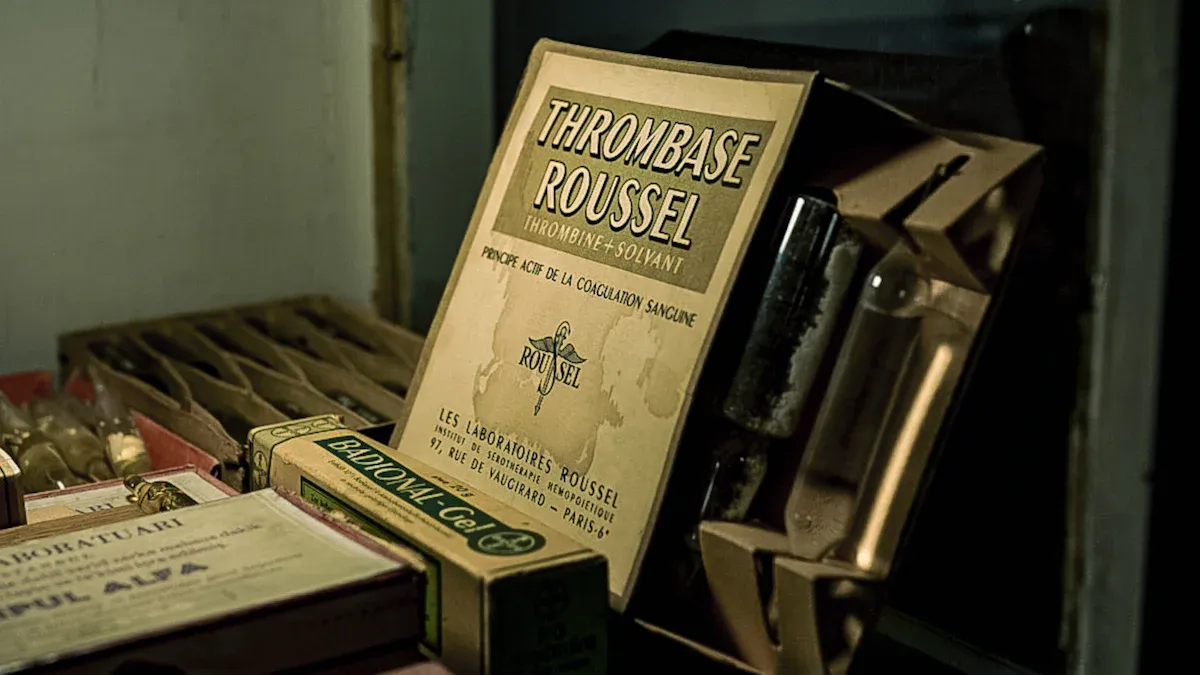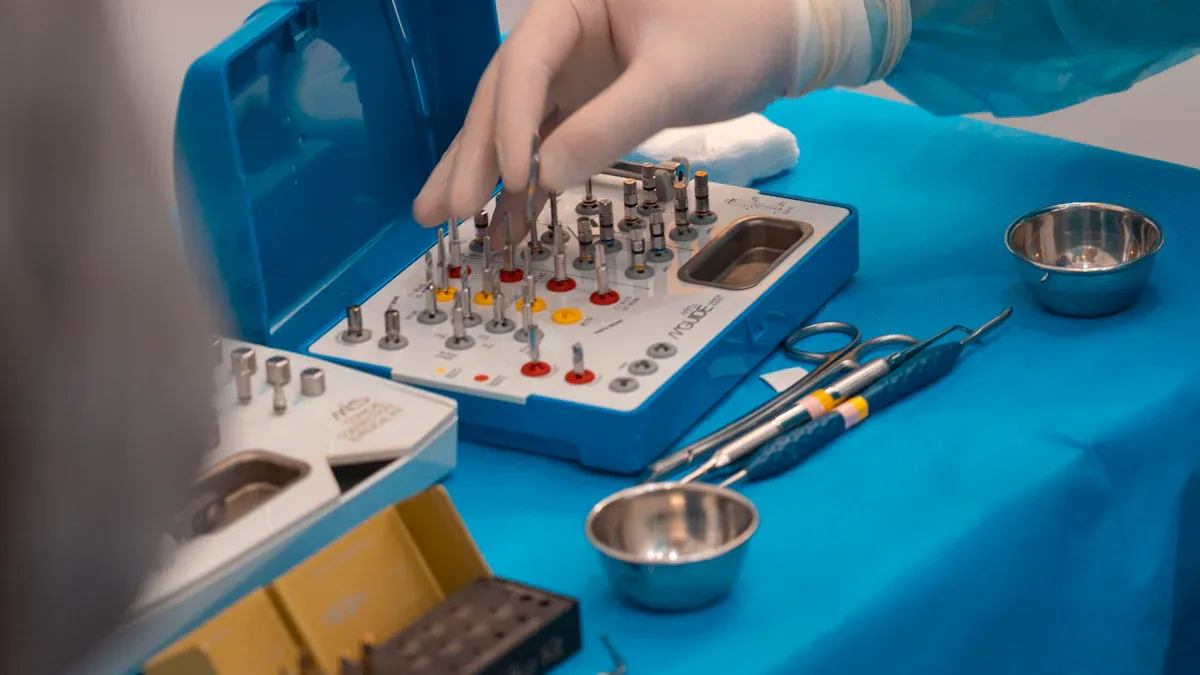Advancements in Laser-Cut Hypotube Technology for 2025

Laser-cut hypotubes play a transformative role in precision manufacturing, offering unmatched accuracy and efficiency. You rely on these components for applications requiring precise fluid delivery, such as drug administration or microfluidics. The materials, including stainless steel and nitinol, ensure durability and flexibility, which are critical for minimizing tissue trauma during medical procedures.
Industries like medical, aerospace, and telecommunications have embraced this technology for its ability to enhance scalability and product quality. For example, medical devices benefit from precise cuts that improve catheter performance, while aerospace applications leverage lightweight structural elements. The advancements in laser cutting technology for 2025 promise to drive further innovation, enabling you to achieve higher efficiency and consistency in manufacturing processes.
Did you know? The flexibility of a hypotube depends on its cutting pattern, which can be tailored to meet specific performance needs.
Industry | Specific Applications |
|---|---|
Medical | Microfluidics, Laboratory Instruments (precision syringes, pipettes) |
Aerospace | Aircraft Components (lightweight structural elements) |
Automotive | Fuel Injectors (efficient fuel delivery in combustion engines) |
Telecommunications | Fiber Optics (data transmission through optical fibers) |
Robotics | Miniature Actuators (precise movements in confined spaces) |
Key Takeaways
Laser-cut tubes improve accuracy in medical tools, helping patients heal faster with less damage.
Machines making these tubes work faster, make fewer mistakes, and cost less, keeping quality steady.
Smart technology predicts problems early, keeping machines working longer with less break time.
Energy-saving lasers use less power and are better for the environment, supporting green goals.
Custom-made laser tubes fit patient needs, working better for medical and other uses.
Innovations in Laser Cutting Technology

Ultrafast Lasers
Enhanced precision and reduced thermal damage.
Ultrafast lasers, such as femtosecond lasers, represent a significant leap in advanced laser cutting. These lasers achieve unparalleled precision by operating with pulse durations shorter than the thermal diffusion time of materials. This prevents heat from spreading, eliminating thermal damage and ensuring cleaner cuts. Unlike traditional nanosecond lasers, which rely on thermal mechanisms, ultrafast lasers use deterministic damage thresholds. This approach minimizes structural changes, making them ideal for sensitive applications like medical devices and microelectronics.
Tip: Ultrafast lasers are particularly effective for creating permanent UDI (Unique Device Identification) marks, ensuring compliance and traceability in medical manufacturing.
Applications in cutting complex geometries for medical and industrial use.
The ability of ultrafast lasers to cut intricate geometries has revolutionized laser cut hypotubes. In medical applications, these lasers enable the production of precise patterns for catheters and stents, enhancing their functionality. Industrial sectors benefit as well, with ultrafast lasers addressing challenges like heat accumulation and material ablation. For example, they excel in processing sensitive polymers without causing melting or combustion, ensuring device usability. This versatility makes ultrafast lasers a cornerstone of the latest trends in laser cutting.
Hybrid Laser Systems
Combining laser types for material adaptability and versatility.
Hybrid laser systems combine multiple laser types to optimize material processing. For instance, pairing a 532nm laser with a 1064nm laser has shown superior results in copper welding, while carbon fiber reinforced polymers achieve better cuts with a mix of 10.6μm and 1.07μm beams. MultiWave Hybrid Technology takes this further by allowing independent control over various laser parameters. This adaptability ensures that laser cut hypotubes meet diverse material requirements, enhancing their quality and performance.
Improved cutting speed and quality in hypotube manufacturing.
Hybrid systems streamline the manufacturing process by automating laser cutting. This automation increases throughput and reduces production cycles without compromising quality. The precision of hybrid lasers ensures uniform dimensions and structural integrity, which is critical for high-quality hypotubes. By leveraging this technology, you can meet growing demand while maintaining consistency and reliability in your products.
Automation and AI in Hypotube Manufacturing
Automated Processes
Increased productivity and reduced human error in laser-cut hypotubes.
Automation has revolutionized the production of laser-cut hypotubes by introducing precision and consistency into the manufacturing process. Automated systems handle tasks like loading and unloading hypotubes onto laser cutting machines, significantly reducing manual intervention. This not only minimizes human error but also ensures uniformity in every cut. With real-time monitoring and quality control integrated into these systems, you can achieve enhanced quality control and improved yield rates.
Precision automation technologies are reshaping the industry, delivering better efficiency and outcomes. By streamlining assembly processes, automation enables increased throughput without compromising quality. This makes it possible to meet growing demand while maintaining high-quality manufacturing standards.
Cost savings through streamlined operations.
Automation also brings substantial cost savings by optimizing the overall process efficiency. Streamlined assembly processes reduce labor costs and minimize material waste. Automated systems work continuously, eliminating downtime associated with manual operations. This ensures that your manufacturing operations remain cost-effective while maintaining the precision required for high-quality hypotubes. The result is a more efficient production line that delivers consistent results at a lower operational cost.
AI-Driven Predictive Maintenance
Real-time monitoring for enhanced equipment reliability.
Artificial intelligence (AI) is transforming laser cutting technology by enabling predictive maintenance. AI-powered systems monitor equipment in real time, identifying potential issues before they escalate. This proactive approach ensures that your laser systems operate at peak performance, reducing the risk of unexpected failures. Enhanced quality control becomes achievable as AI systems analyze data to maintain optimal cutting conditions, ensuring consistent precision in every hypotube produced.
Minimizing downtime and extending the lifespan of laser systems.
Predictive maintenance powered by AI minimizes downtime by addressing equipment issues before they disrupt production. This not only improves throughput but also extends the lifespan of your laser systems. By reducing wear and tear through timely interventions, you can maximize the yield of your manufacturing operations. AI-driven maintenance ensures that your technology remains reliable, supporting high-quality manufacturing and sustained efficiency.
Sustainability in Laser-Cut Hypotube Technology
Energy-Efficient Systems
Reduced power consumption and operational costs.
Modern laser systems prioritize energy efficiency, reflecting a growing commitment to sustainable manufacturing. These systems are engineered to consume less power while maintaining high levels of precision and performance. By reducing energy usage, you can significantly lower operational costs, making your production process more cost-effective. This shift not only benefits your bottom line but also aligns with the increasing demand for environmentally responsible practices in the industry.
Energy-efficient laser systems also enhance the flexibility of your operations. Advanced designs allow you to optimize power settings based on material requirements, ensuring minimal waste and maximum efficiency. This adaptability is particularly valuable in the production of laser-cut hypotubes, where precision and quality are paramount. As a result, you can achieve superior outcomes while conserving resources.
Lower carbon footprint in manufacturing processes.
Adopting energy-efficient laser cutting technology helps you reduce the carbon footprint of your manufacturing processes. These systems minimize energy waste, contributing to a cleaner and more sustainable production environment. By integrating such technology, you can meet global sustainability standards and appeal to environmentally conscious clients. This proactive approach positions your business as a leader in sustainable innovation, giving you a competitive edge in the market.
Use of Recyclable Materials
Adoption of eco-friendly materials in hypotube production.
Sustainability extends beyond energy efficiency to the materials used in hypotube production. By incorporating recyclable and eco-friendly materials, you can reduce waste and promote a circular economy. Stainless steel and nitinol, commonly used in hypotubes, are highly recyclable, making them ideal for sustainable manufacturing. This approach not only conserves resources but also ensures compliance with environmental regulations.
Using recyclable materials also enhances the quality of your products. These materials maintain their structural integrity during recycling, ensuring that your laser-cut hypotubes meet the highest standards of durability and performance. This commitment to sustainability and quality reinforces your reputation as a forward-thinking manufacturer.
Alignment with global sustainability goals and regulations.
Incorporating recyclable materials and energy-efficient systems aligns your operations with global sustainability goals, such as the United Nations' Sustainable Development Goals (SDGs). By adopting these practices, you demonstrate your dedication to reducing environmental impact and supporting a greener future. Compliance with international regulations also ensures that your products remain competitive in global markets, safeguarding your business's long-term success.
Note: Sustainability is not just a trend; it is a necessity. By embracing eco-friendly practices, you contribute to a healthier planet while enhancing the efficiency and flexibility of your manufacturing processes.
Expanded Applications of Laser-Cut Hypotubes

Medical Devices
Enhanced precision for minimally invasive procedures.
Laser-cut hypotubes have revolutionized minimally invasive medical procedures by offering unmatched precision and functionality. These hypotubes are essential in catheter system manufacturing, where their small size and flexibility allow them to navigate complex vascular pathways. This precision ensures that tools and medications can be delivered accurately, minimizing trauma to surrounding tissues. For example, hypotubes are widely used in cardiovascular catheterization and urological procedures, where their design supports high-performance outcomes. Their role in medical imaging equipment, such as CT scans and MRI systems, further highlights their versatility in critical applications.
The advanced design flexibility of laser-cut hypotubes enhances their performance in these procedures. Engineers can create intricate patterns and geometries tailored to specific clinical needs, optimizing torque response and pushability. This customization ensures that each catheter system meets the unique requirements of its application, improving patient outcomes and procedural success rates.
Customization for patient-specific solutions, such as the Element Vascular Access System.
Customization has become a cornerstone of modern catheter system manufacturing. Laser-cut hypotubes enable the production of patient-specific solutions, such as the Element Vascular Access System. By prioritizing catheter reinforcement, these hypotubes streamline the manufacturing process, reducing the need for multiple durometer jackets. This approach not only improves efficiency but also enhances the quality of the final product.
The ability to tailor hypotube designs to individual patient needs ensures optimal performance. Engineers can craft intricate patterns that enhance flexibility, kink resistance, and tensile strength. This level of customization supports a wide range of medical applications, from routine procedures to complex interventions, making laser-cut hypotubes indispensable in modern healthcare.
3D Laser Cutting
Complex designs for aerospace and automotive industries.
3D laser cutting technology has transformed the production of complex designs in aerospace and automotive industries. This method allows you to cut at multiple angles, enabling the creation of intricate geometries with precision. Engineers can design parts with curves and contours that would be impossible to achieve using traditional cutting techniques. This capability eliminates the need for additional machining, streamlining the manufacturing process and enhancing efficiency.
The versatility of 3D laser cutting machines further supports these industries. These machines can perform multiple functions, including drilling, engraving, and welding, making them ideal for producing high-quality components. Whether you need basic cuts or intricate designs, 3D laser cutting technology ensures consistent results, meeting the demanding standards of modern manufacturing.
Faster prototyping and production cycles.
Faster prototyping is another significant advantage of 3D laser cutting technology. This method accelerates the development process by enabling quick testing and iteration of designs. CAD software allows you to create models rapidly, facilitating efficient prototyping. The clean finish achieved by 3D laser cutting eliminates the need for after-treatment, saving time and reducing costs.
Prototyping with 3D laser cutting also helps identify design flaws early, preventing costly errors during mass production. This approach ensures that your final product meets all performance and quality standards. By speeding up production cycles and minimizing material waste, 3D laser cutting technology supports sustainable and cost-effective manufacturing practices.
Advancements in Software and User Interfaces
Intuitive Control Systems
Simplified operation for technicians and engineers.
Modern laser-cutting systems prioritize user-friendly interfaces to simplify operations for technicians and engineers. Intuitive touchscreen interfaces allow you to navigate machine settings effortlessly, reducing the complexity of tasks like laser power modulation, motion control, and material handling. High-resolution encoders and powerful servo motors ensure precise positioning and smooth motion, while look-ahead algorithms optimize trajectory planning. These features enhance the overall usability of laser-cut hypotubes manufacturing systems, making them accessible even to less experienced operators.
Safety remains a top priority in these systems. Integrated safety interlocks, beam path monitoring, and overload protection ensure secure operation. Intelligent fault detection and diagnostics further streamline troubleshooting, enabling you to maintain productivity without unnecessary delays. By adopting these advanced control systems, you can achieve higher efficiency and precision in your manufacturing processes.
Reduced training time and improved usability.
The intuitive design of modern software reduces the learning curve for new users. CAD/CAM integration simplifies the transition from design to production, allowing you to focus on innovation rather than technical challenges. Real-time position feedback and closed-loop control systems provide immediate insights, helping operators make adjustments quickly. This minimizes the need for extensive training, enabling your team to adapt to new systems with ease. Enhanced usability ensures that your operations remain efficient, even as you scale production.
Cloud-Based Solutions
Remote access and real-time updates for laser-cutting systems.
Cloud-based platforms revolutionize how you manage laser-cutting systems. With centralized data management, you can store and access design files and machine settings from anywhere. This flexibility allows you to monitor and control operations remotely, ensuring seamless production even when you're off-site. Real-time updates keep your systems running at peak performance, reducing downtime and enhancing overall efficiency.
Enhanced collaboration and data security in manufacturing.
Cloud solutions foster collaboration by enabling teams to work on designs and adjustments simultaneously. Real-time collaboration ensures that changes are implemented quickly, reducing delays in production. Scalable platforms accommodate businesses of all sizes, making them ideal for growing operations. Advanced security measures, such as encrypted data storage and access controls, protect sensitive information, ensuring that your manufacturing processes remain secure. By leveraging cloud-based solutions, you can enhance productivity and maintain a competitive edge in the industry.
The advancements in laser-cut hypotubes for 2025 redefine precision and efficiency in manufacturing. Features like unparalleled design flexibility, enhanced kink resistance, and streamlined processes ensure superior performance in medical and industrial applications. These innovations, coupled with AI and 3D printing, boost productivity and reduce costs, transforming the manufacturing landscape. To stay competitive, you should adopt automation, AI-driven optimization, and energy-efficient systems. By embracing these technologies, you align with sustainability goals and position your business for long-term success in a rapidly evolving industry.
Tip: Investing in cutting-edge technology today ensures your relevance tomorrow.
FAQ
What are the key benefits of laser-cut hypotubes in medical applications?
Laser-cut hypotubes provide unmatched precision and flexibility, making them ideal for minimally invasive procedures. They enhance catheter performance, reduce tissue trauma, and allow for patient-specific customization. These features improve procedural outcomes and ensure high-quality medical device manufacturing.
How does automation improve hypotube manufacturing?
Automation increases productivity by streamlining processes like loading and cutting. It reduces human error, ensures consistent quality, and lowers operational costs. Automated systems also enable real-time monitoring, allowing you to meet growing demand efficiently while maintaining high manufacturing standards.
Are laser-cut hypotubes environmentally friendly?
Yes, they align with sustainability goals. Manufacturers use recyclable materials like stainless steel and nitinol, reducing waste. Energy-efficient laser systems further minimize the carbon footprint, making the production process eco-friendly and compliant with global environmental regulations.
Can laser-cut hypotubes be customized for specific industries?
Absolutely! Laser-cut hypotubes can be tailored to meet the unique requirements of industries like medical, aerospace, and automotive. Engineers design intricate patterns and geometries to optimize performance, ensuring the hypotubes meet the specific needs of each application.
See Also
Latest Developments in PTFE Catheter Manufacturing Techniques
New Innovations in FEP Tubing for Healthcare Applications
Transformative Innovations in PTFE Liners for Medical Equipment

